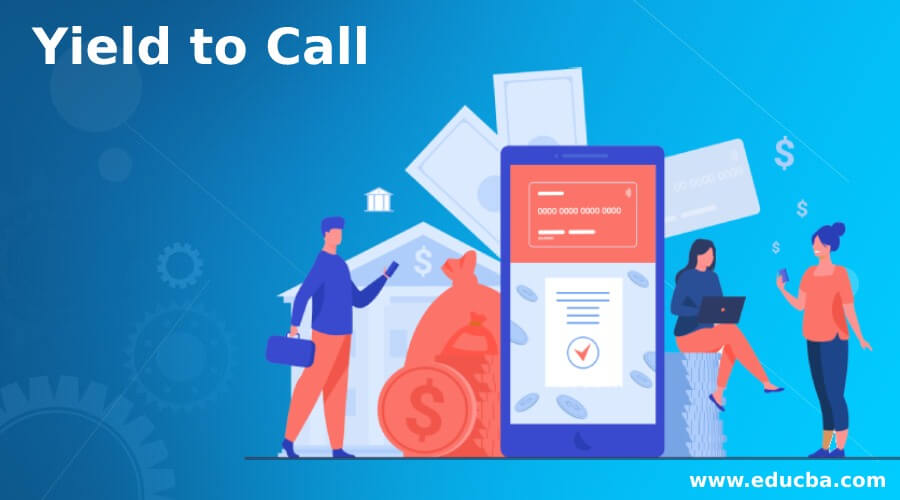Updated July 7, 2023
What is Yield to Call
The term “yield to call” refers to the return that a bondholder is expected to receive if the bond is held until the call date, which takes place well before the scheduled maturity date. It does not apply to all fixed-income securities but only to callable bonds – debt instruments that let the bond issuers repurchase them on the call date at a pre-determined price, known as call price.

Explanation
As these bonds provide the option to the issuers to retire them on a date that is somewhat before the actual maturity date, the investors need to be paid a relatively higher premium. The investors of the callable bond can estimate the yield to call, which is the total return they will receive if the bond is held until the call date instead of the maturity date.
Formula
Its approximate value can calculate on the basis of cash flows from the coupon payments and the redemption proceeds received during the Call. Hence, its formula can be expressed in terms of its annual coupon payment, call price, current market price, and the number of years until the call date. Mathematically, it is represented as,
Examples of Yield to Call
Different examples are mentioned below:
Example #1
Let us take the example of a $1,000 par value zero-coupon bond that matures in three years and is callable in two years at a call price that is 98% of the par value. First, determine the yield to call the bond if its current market price is $887.
Solution:
- Given, Par value = $1,000
- Number of years until call = 2
- Market price = $887
Call price = 98% * Par value
- Call price = 98% * $1,000
- Call price = $980
Now, the yield to call of the bond can be calculated using the above formula,
Yield to Call = (annual Coupon Payment+ (call Price – Market Price)/ Number of Years until Call)/((Call Price + Market Price)/2)
- Yield to Call = ($0 + ($980 – $887) / 2)/(($980 + $887)/2)
- Yield to Call = 4.98%
Therefore, the yield to call the zero-coupon bond is 4.98%.
Example #2
Let us take the example of John, who purchased a $1,000 par value bond with a 5% annual coupon. Although the bond matures in five years, it can be called by the issuer at the end of three years at a call price of 105% of the par value. First, determine the yield to call the bond if its current market price is $985.
Solution:
- Given, Par value = $1,000
- Number of years until call = 3
- Annual coupon rate = 5%
Market price = $985
Annual Coupon payment = Annual coupon rate * Par value
- Annual Coupon payment = 5% * $1,000
- Annual Coupon payment = $50
Call price = 105% * Par value
- Call price = 105% * $1,000
- Call price = $1,050
Now, the yield to call of the bond can calculate by using the above formula,
Yield to Call = (annual Coupon Payment+ (call Price – Market Price)/ Number of Years until Call)/((Call Price + Market Price)/2)
- Yield to Call = ($50 + ($1,050 – $985) / 3)/(($1,050 + $985)/2)
- Yield to Call = 7.22%
Therefore, the yield to call the bond is 7.22%.
Diagram
Typically, callable bonds display negative convexity at low yield levels and positive convexity at high yield levels. As long as the required yield for the callable bonds is more significant than their coupon rate, the bond issuer won’t be willing to retire them. Hence, the bonds exhibit positive convexity similar to option-free bonds. However, when the required yield of the bonds goes below their coupon rate, the call option’s value surges as the issuer’s probability of calling the bonds increases. Hence, the price of callable bonds doesn’t fall as much as option-free bonds as the price decline is limited up to the call price. Therefore, these bonds exhibit negative convexity at low yield levels.
Advantages of Yield to Call
Some of the significant advantages are as follows:
- The issuers get to know at what point it is feasible to call the bonds and refinance them at a lower rate in a market where interest rates are dropping.
- The investors get a fair idea about the return they can expect from the bonds if the issuers repurchase them before their maturity date.
Disadvantages
Some of the major disadvantages are as follows:
- In a market with falling interest rates, the true yield of a callable bond is usually less than its yield to maturity. The reason is that the call provision limits the potential for price appreciation.
- The investors are more exposed to reinvestment risk as the issuers of the current bonds are likely to retire them if the interest rates fall.
Conclusion
So, it can be seen that it is one of the most valuable ways for investors to prepare themselves for interest rate volatility. Most investors calculate the returns based on the various call dates, which lets them assess what can be the worst expected return for a particular callable bond. In this way, the investors can use it to make decisions about purchasing callable bonds.
Recommended Articles
This is a guide to Yield to Call. Here we also discuss the definition and examples of it along with its advantages and disadvantages. You may also have a look at the following articles to learn more –

